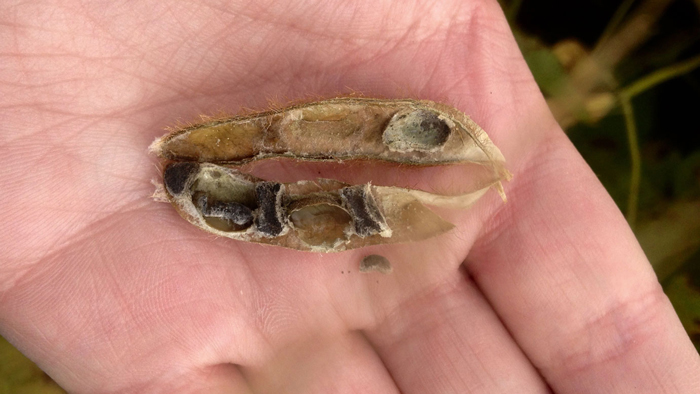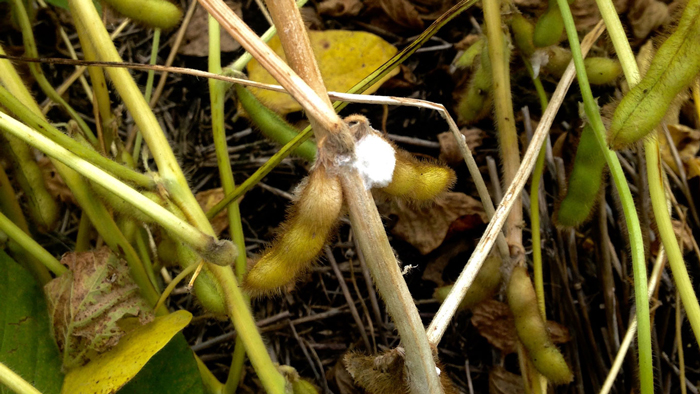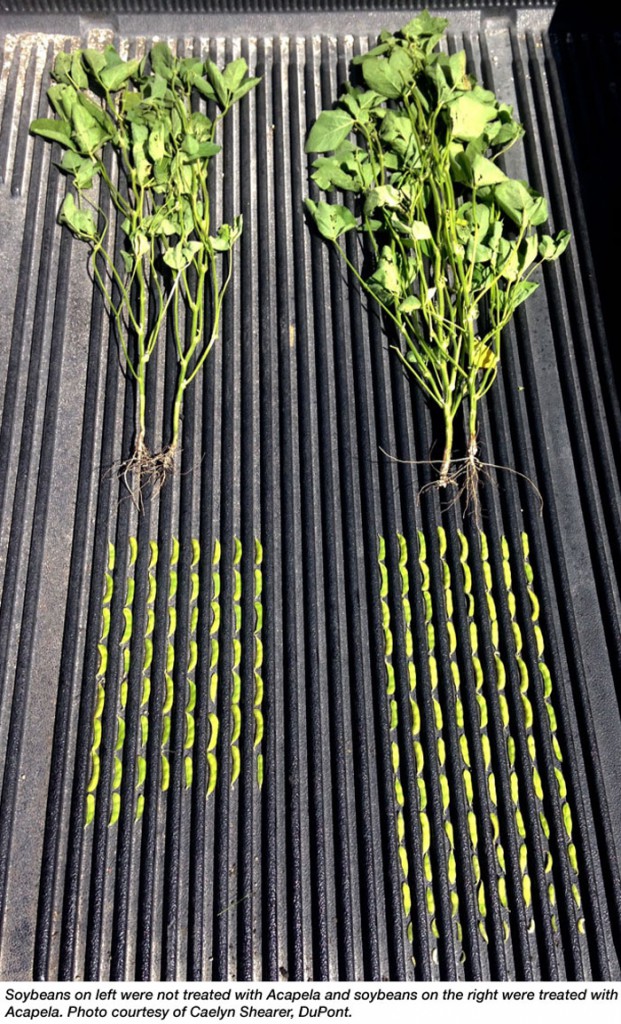Know What to do if White Mould Shows up in Your Soybeans
White mould in soybeans is not the concern in Manitoba and Saskatchewan as it is in Eastern Canada, but pulse crop experts for the west say it is only a matter of time.
White mould, which is caused by the pathogenic fungus Sclerotinia sclerotiorum, is spread readily through broadleaf crops and wet weather.
“White mould is starting to show up more because soybeans are susceptible to sclerotinia and our climates are conducive for sclerotinia,” says Glen Forster, BASF technical marketing specialist for fungicides, Western Canada. “Considering that canola is typically part of a soybean rotation, there’s that chance under wet years that sclerotinia becomes an issue for Western Canada soybeans.”

White mould infected soybean pods. Photo taken in Manitoba. Photo Courtesy of Caelyn Shearer, DuPont
Sclerotinia has a greater impact on canola, sunflowers, and dry edible beans than on soybeans, but all three broadleaf crops are commonly used in soybean rotation.
Forster says while a preventative application of fungicide is best it may not always be cost effective as white mould doesn’t occur every year.
“If they’ve got good yield potential and good dense crop canopy and there’s been a lot of moisture over the last little bit, those are the conditions that are more conducive for sclerotinia development,” he says.
Another concern that soybean growers face is the difficulty in timing for application of a fungicide, says Doug Fotheringham, Sygenta’s agronomic service representative for Manitoba. A soybean plant starts flowering at the R1 stage and flowers for 30 or more days. Typically, products presently available on the market require application at the R1 or R2 stage, some at the R3 stage.
He adds that soybean flowers, which occur in the canopy, on the stem, and under the leaves are “a hard target to hit” with a fungicide application.
“You might be getting a little bit of protection up front, but typically white mould might set in a little bit later and that’s where we struggle with that a little bit. That single application up front, I think has its challenges. Sometimes it does pay, but it’s not consistent,” says Fotheringham.
While the “architecture” of a soybean plant may make fungicide application difficult, it’s also one of the reasons why soybeans are not as susceptible to white mould as other broadleaf crops, says Dale Risula, provincial specialist for pulse crops, with the Saskatchewan government. And in some cases, he points out, late-season white mould can be beneficial as it dries out the plant.
“It depends on the time of the infection. If it’s later and it’s not terribly wet outside, so it doesn’t progress rapidly, it might be a benefit. But that’s not always the case. If the infection occurs early and it is very wet, and the disease grows rapidly it can, of course, have a big impact on the yield and reduce fields quite dramatically,” he says.
Because white mould is not consistent, Risula encourages producers to scout their fields, a practise already carried out by canola growers. Little mushroom-like structures that can be found growing in soil early in the year indicate the strong possibility of sclerotinia.
“Go out and look for problems before they arise,” he says.

Dr. Michael Wunsch, with Carrington Research Centre at North Dakota State University, agrees fungicides are a tool that can be used against white mould, but “it’s really a risk-based assessment. It requires fairly high disease pressure for the application to pay for itself.”
Wunsch says at bloom initiation and full bloom, the producer has to decide based on the history of his field and weather conditions, what the risk of white mould is going to be. If he determines the risk is relatively high, then he would apply a fungicide.
Wunsch points out that because of the shorter growing season in Western Canada, soybeans are of a shorter maturity length and are generally less susceptible to white mould.
“For a fungicide to pay, they really need to have some kind of significant pressure,” says Wunsch.
Two fungicides relatively new to the market offer producers a viable option in the increasing battle against white mould in soybeans.
Acapela, launched in 2013 across Canada by EI duPont Canada Company, is experiencing one of its fastest rates of growth in soybean use.
“It’s commonly used across Western Canada for the suppression of sclerotinia white mould in soybeans and has been performing very well since we launched it,” says Kirsten Ratzlaff, Pulse and Oilseeds Market Segment Manager with DuPont. “What we’re really seeing is that its adoption is due to its field performance. We’re seeing its performance visually, we’re seeing it in yield, and we’re hearing about it with positive grower feedback.”

Ratzlaff says she recommends spraying Acapela at beginning bloom as a preventive application.
“Acapela has a great ability of moving through the leaves and the stem of the plant, adding more value by providing exceptional coverage,” she says.
Ratzlaff notes that Acapela is also registered for control of sclerotinia in canola and suppression in peas, lentils, dry beans, and is also effective against other leaf diseases.
“(If the grower) is making the decision to spray in soybeans because the conditions are there, likely they’re there in other crops. The great thing about Acapela is that you can use one fungicide to cover multiple crops. It just makes things a little easier for the grower,” she says.
While Acapela suppresses white mould, Syngenta offers Allegro, which, as far as Fotheringham knows, is the only registered fungicide on the market that fully controls white mould in soybeans. Allegro is registered for two white mould application rates. The full application rate is recommended when a white mould-susceptible variety has been planted or if the field has a history of severe white mould pressure. Growers can use the reduced application rate for enhanced disease suppression and protection if planting resistant soybean varieties.
“Lots of companies are coming out with new products, so some products may in the near future have control,” says Fotheringham.
As more acres are planted to soybeans, more and more companies will be working toward fungicides to help with soybean yield.
Another method to deal with white mould is seeding to wide rows. As the canopy closes later and there is more air flowing through the canopy, says Wunsch, white mould tends to be less severe. But a slower closing canopy has implications for weed management.
“When you have very cool wet weather during bloom, white mould can be an economically important disease and very wide row spacing is effective at reducing white mould but has other agronomic impacts that must be considered,” he says. “What we find even under significant white mould pressure sometimes those wide rows were not maximizing yield.”
Choosing soybean varieties less susceptible to white mould is also an option. But that also has its challenges, says Wunsch. The susceptibility ratings provided by breeders or companies are often “not highly accurate because the companies don’t typically have enough data to give really good assessments for white mould” as the disease pressure is uneven.
“Breeding will be the next answer,” says Risula. “That usually takes a number of years before you get resistance in place.”


